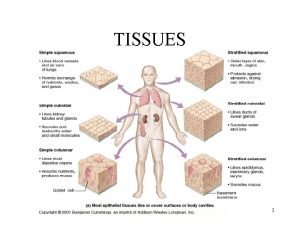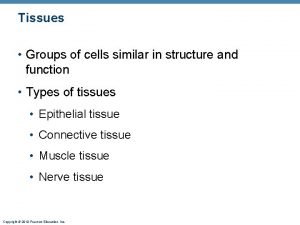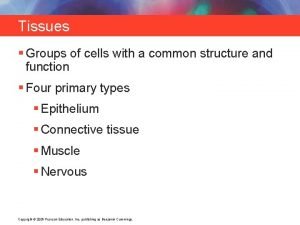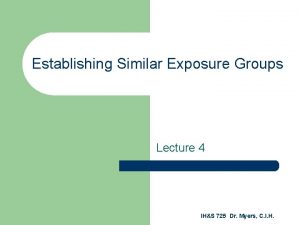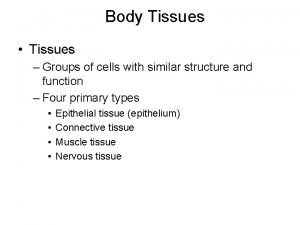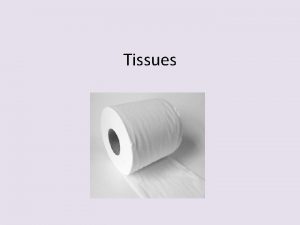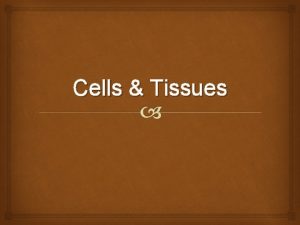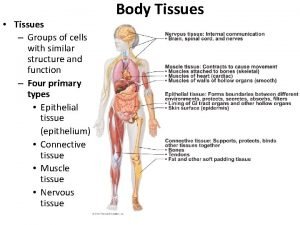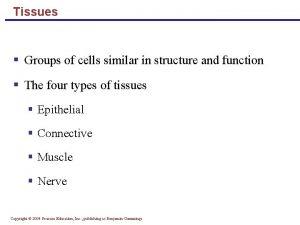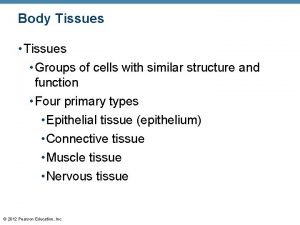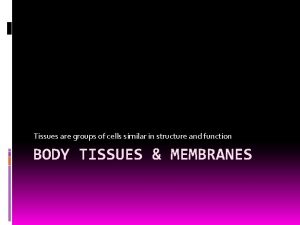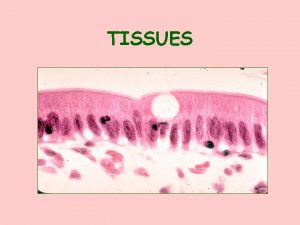Tissues Groups of cells similar in structure and



















- Slides: 19


Tissues • Groups of cells similar in structure and function • Types of tissues • Epithelial tissue • Connective tissue • Muscle tissue • Nerve tissue

Nervous tissue: Internal communication • Brain, spinal cord, and nerves Muscle tissue: Contracts to cause movement • Muscles attached to bones (skeletal) • Muscles of heart (cardiac) • Muscles of walls of hollow organs (smooth) Epithelial tissue: Protects, secretes, absorbs, filters • Skin surface (epidermis) • Lining of GI tract organs and other hollow organs Connective tissue: Supports, protects, binds other tissues together • Bones • Tendons • Fat and other soft padding tissue Figure 4. 1

Epithelial Tissue (Epithelium) • Two main types (by location): 1. Covering and lining epithelia • On external and internal surfaces 2. Glandular epithelia • Secretory tissue in glands


Apical surface Basal surface Simple Apical surface Basal surface Stratified (a) Classification based on number of cell layers. Figure 4. 2 a

Squamous Cuboidal Columnar (b) Classification based on cell shape. Figure 4. 2 b



Endocrine gland


Unicellular Exocrine Glands • The only important unicellular gland is the goblet cell

Multicellular Exocrine Glands • Multicellular exocrine glands are composed of a duct and a secretory unit • Classified according to: • Duct type (simple or compound) • Structure of their secretory units (tubular, alveolar, or tubuloalveolar)

Tubular secretory structure Simple duct structure Compound duct structure (duct does not branch) (duct branches) Simple tubular Simple branched tubular Example Compound tubular Intestinal glands Stomach (gastric) glands Duodenal glands of small intestine Simple alveolar Simple branched alveolar Compound alveolar Example No important example in humans Sebaceous (oil) glands Mammary glands Example Alveolar secretory structure Surface epithelium Duct Compound tubuloalveolar Example Salivary glands Secretory epithelium Figure 4. 5


Characteristics of Epithelial Tissue § Cells have polarity ü ü Apical (upper, free) Basal (lower, attached) ØApical surfaces may bear • • Microvilli (e. g. , brush border of intestinal lining) Cilia (e. g. , lining of trachea)


Types of Cell Junctions

Types of Cell Junctions
 Tissues are groups of similar cells working together to
Tissues are groups of similar cells working together to Tissues are groups of similar cells working together to
Tissues are groups of similar cells working together to Tissues are groups of similar cells working together to:
Tissues are groups of similar cells working together to: Body tissues chapter 3 cells and tissues
Body tissues chapter 3 cells and tissues 4 body tissues
4 body tissues Body tissues chapter 3 cells and tissues
Body tissues chapter 3 cells and tissues Stained cheek cell
Stained cheek cell Cells form tissues. tissues form __________.
Cells form tissues. tissues form __________. Groups of cells that are similar in structure and function
Groups of cells that are similar in structure and function Chapter 3 cells and tissues figure 3-7
Chapter 3 cells and tissues figure 3-7 Chapter 3 cells and tissues figure 3-1
Chapter 3 cells and tissues figure 3-1 What is the function of the golgi apparatus
What is the function of the golgi apparatus Muscle tissue parts
Muscle tissue parts Cells-tissues-organ-systems-organism
Cells-tissues-organ-systems-organism How are ethnic groups and religious groups related
How are ethnic groups and religious groups related Onodi cells and haller cells
Onodi cells and haller cells Chlorocruorin
Chlorocruorin Animal cell venn diagram
Animal cell venn diagram Masses of cells form and steal nutrients from healthy cells
Masses of cells form and steal nutrients from healthy cells Similar exposure group
Similar exposure group

